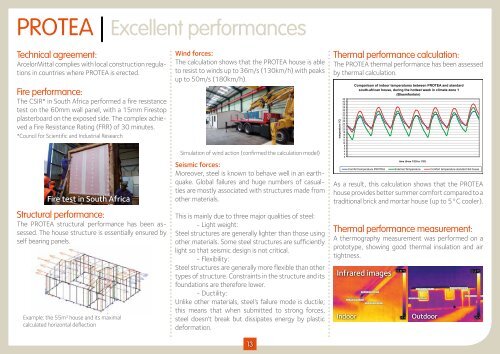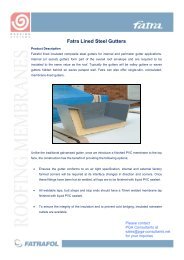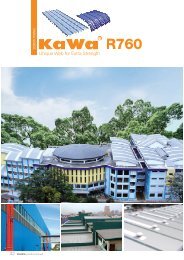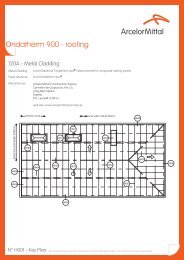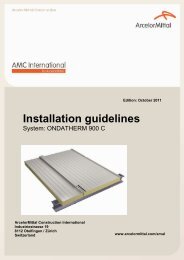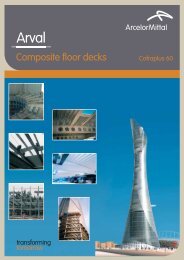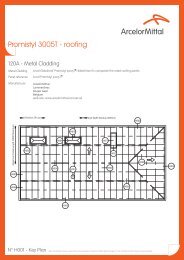protea - PGA Consultants
protea - PGA Consultants
protea - PGA Consultants
Create successful ePaper yourself
Turn your PDF publications into a flip-book with our unique Google optimized e-Paper software.
PROTEA | Excellent performances<br />
Technical agreement:<br />
ArcelorMittal complies with local construction regulations<br />
in countries where PROTEA is erected.<br />
Fire performance:<br />
The CSIR* in South Africa performed a fire resistance<br />
test on the 60mm wall panel, with a 15mm Firestop<br />
plasterboard on the exposed side. The complex achieved<br />
a Fire Resistance Rating (FRR) of 30 minutes.<br />
*Council for Scientific and Industrial Research<br />
Fire test in South Africa<br />
Structural performance:<br />
The PROTEA structural performance has been assessed.<br />
The house structure is essentially ensured by<br />
self bearing panels.<br />
Example: the 55m² house and its maximal<br />
calculated horizontal deflection<br />
Wind forces:<br />
The calculation shows that the PROTEA house is able<br />
to resist to winds up to 36m/s (130km/h) with peaks<br />
up to 50m/s (180km/h).<br />
Simulation of wind action (confirmed the calculation model)<br />
Seismic forces:<br />
Moreover, steel is known to behave well in an earthquake.<br />
Global failures and huge numbers of casualties<br />
are mostly associated with structures made from<br />
other materials.<br />
This is mainly due to three major qualities of steel:<br />
- Light weight:<br />
Steel structures are generally lighter than those using<br />
other materials. Some steel structures are sufficiently<br />
light so that seismic design is not critical.<br />
- Flexibility:<br />
Steel structures are generally more flexible than other<br />
types of structure. Constraints in the structure and its<br />
foundations are therefore lower.<br />
- Ductility:<br />
Unlike other materials, steel’s failure mode is ductile;<br />
this means that when submitted to strong forces,<br />
steel doesn’t break but dissipates energy by plastic<br />
deformation.<br />
13<br />
Thermal performance calculation:<br />
The PROTEA thermal performance has been assessed<br />
by thermal calculation.<br />
temperature (°C)<br />
42<br />
40<br />
38<br />
36<br />
34<br />
32<br />
30<br />
28<br />
26<br />
24<br />
22<br />
20<br />
18<br />
16<br />
14<br />
12<br />
10<br />
8<br />
6<br />
4<br />
2<br />
0<br />
As a result, this calculation shows that the PROTEA<br />
house provides better summer comfort compared to a<br />
traditional brick and mortar house (up to 5°C cooler).<br />
Thermal performance measurement:<br />
A thermography measurement was performed on a<br />
prototype, showing good thermal insulation and air<br />
tightness.<br />
Infrared images<br />
Indoor<br />
Comparison of indoor temperatures between PROTEA and standard<br />
south-african house, during the hottest week in climate zone 1<br />
(Bloemfontein)<br />
time (from 1/25 to 1/31)<br />
Comfort temperature PROTEA External Temperature Comfort temperature standard SA house<br />
Outdoor


